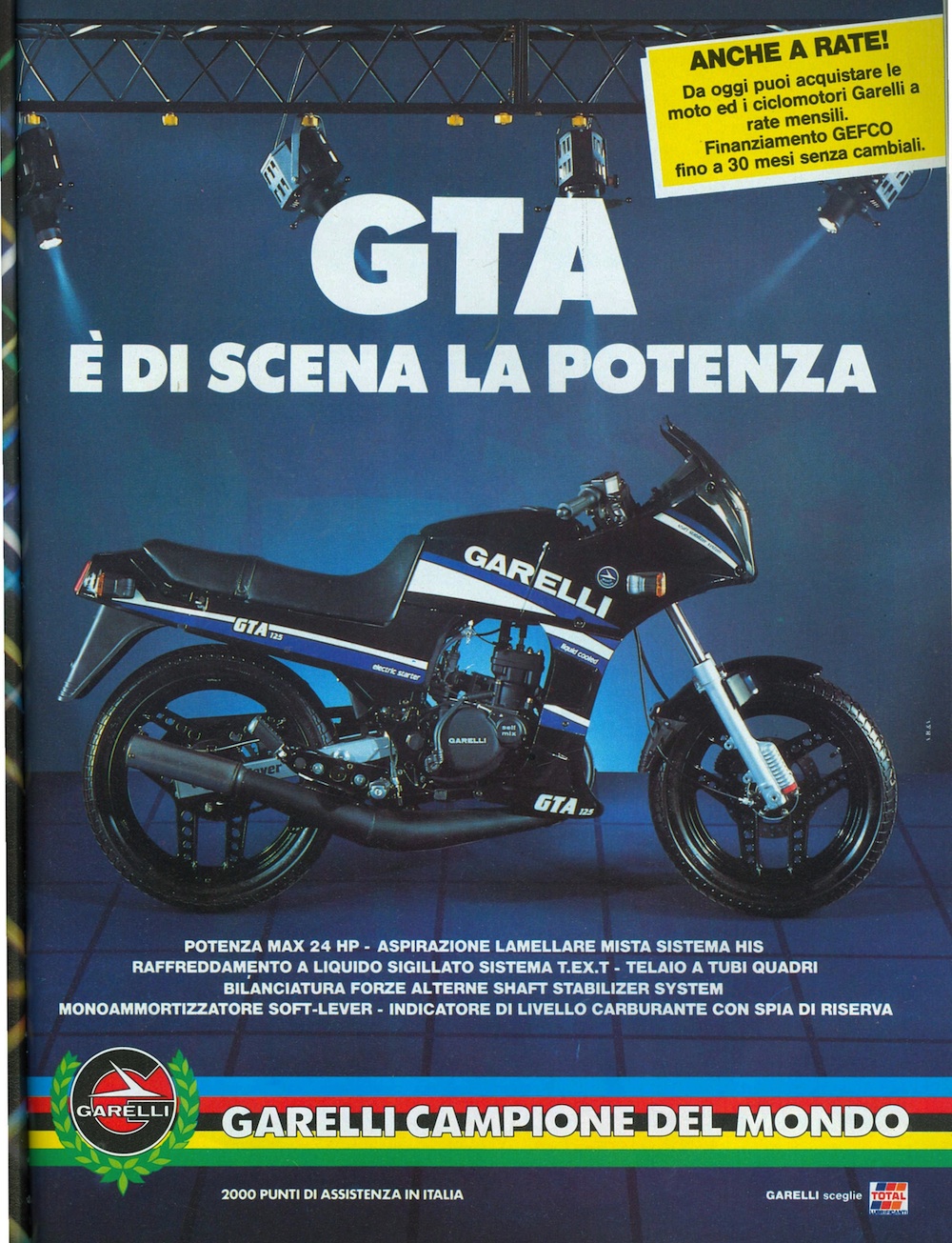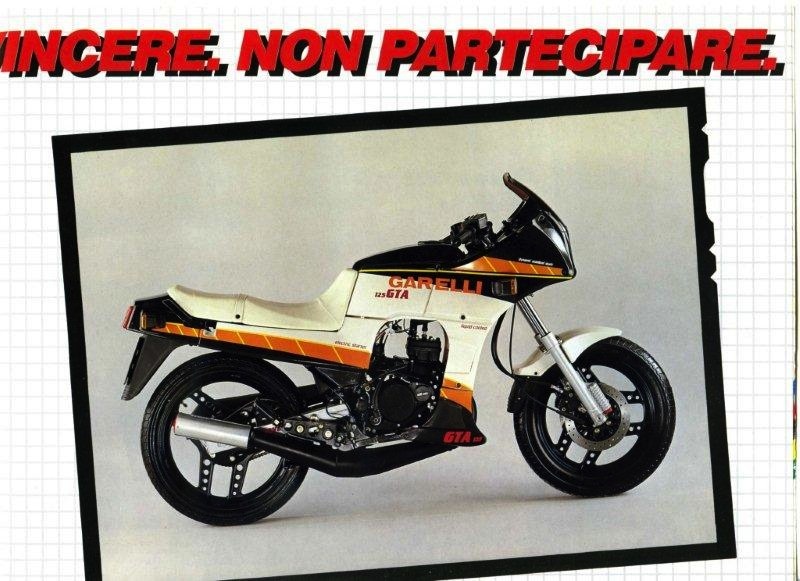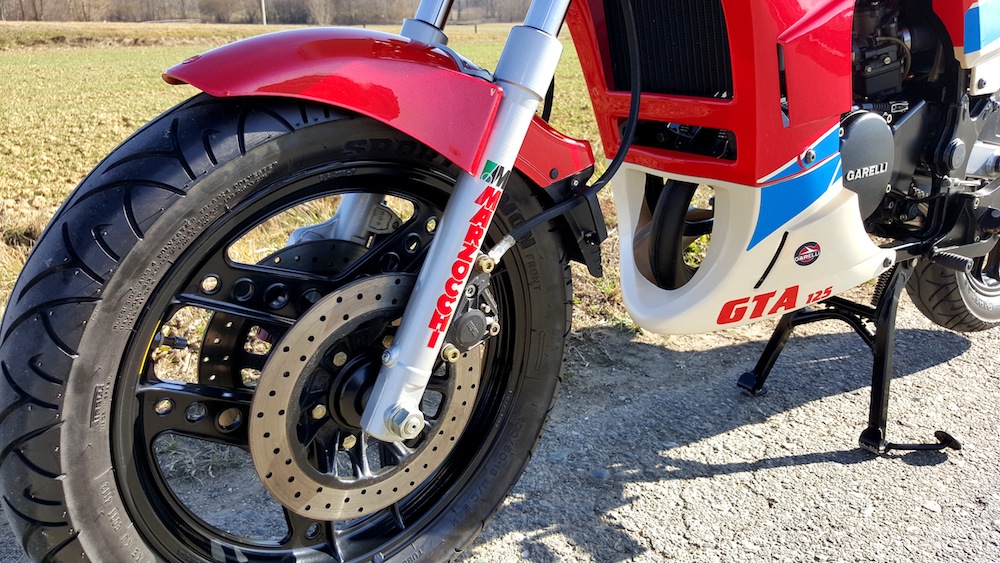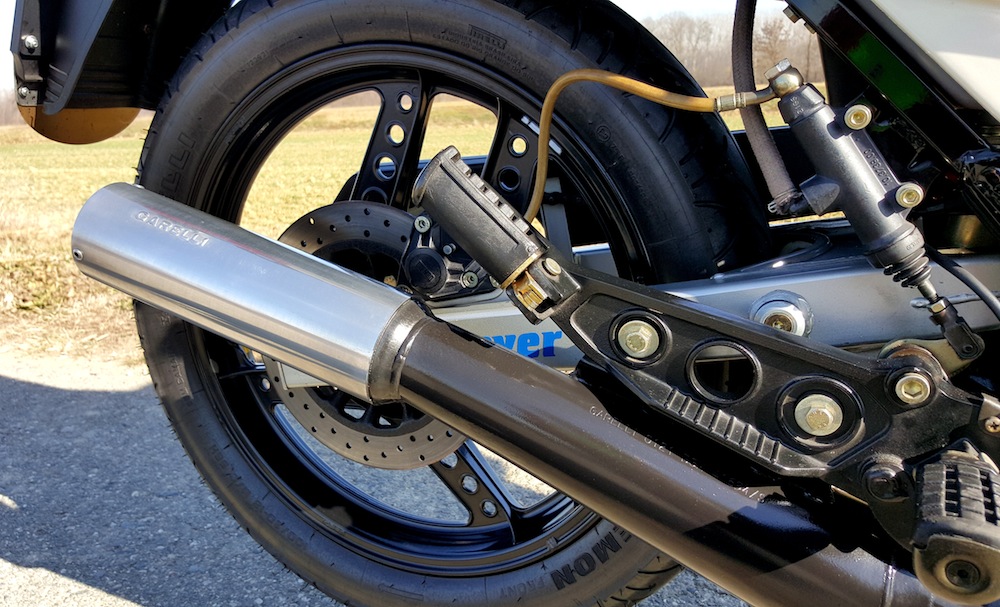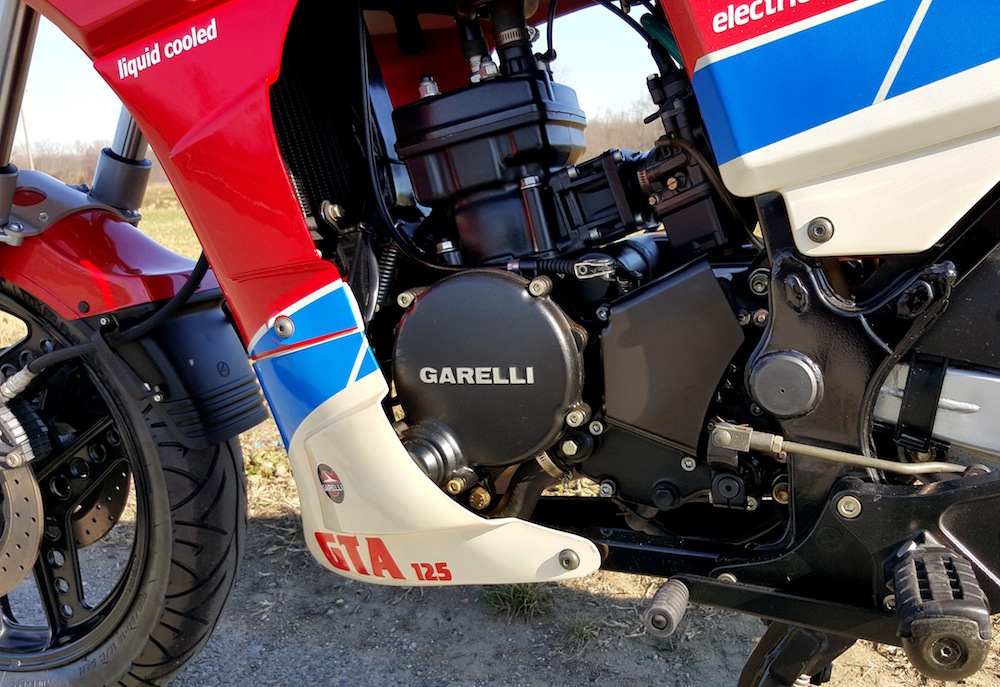La Garelli nasce a Sesto San Giovanni, in provincia di Milano, nel lontano 1919. La produzione si concentrava principalmente intorno alla “350” per poi progressivamente spostarsi su apparati per uso militare come motocompressori e generatori, a tal punto che sul finire degli anni 30 la Garelli non risultava più menzionata nell’elenco delle fabbriche italiane di motociclette. Archiviata la seconda guerra mondiale, la grande necessità di mezzi di trasporto economici che affliggeva il paese spostò l’attenzione della stragrande maggioranza delle aziende precedentemente impegnate in ambito bellico alla produzione di piccoli motocicli. Così la Garelli nel 1953 tornò nel mondo delle due ruote con il Mosquito, un innovativo motore ausiliario da 38,5 cm³ destinato a equipaggiare le comuni biciclette.
Nel 1961 avvenne la fusione fra la Agrati e la Garelli, due aziende che già collaboravano strettamente. Difatti, l’Agrati comperava dalla Garelli motori per i suoi scooter, mentre la Garelli acquistava dalla Agrati i telai che poi le faceva anche assemblare. Negli anni Sessanta la produzione vide la nascita di modelli che avrebbero reso estremamente popolare il marchio Garelli (che in sostanza sostituì il marchio Agrati) su ciclomotori come il modello “M” (come Mosquito) che poi si trasformerà nel 1969 nel famoso e diffusissimo Gulp. Negli anni 70 arrivarono poi il VIP ed il tubone Ciclone che capitalizzò molto su un fenomeno di moda, quello dei tuboni, che in quegli anni spopolavano tra i giovani.
La produzione Garelli era quindi sempre stata incentrata prevalentemente su ciclomotori, fatto salvo per qualche modello da enduro. Con l’inizio degli anni 80 e la grande passione che muoveva Daniele Agrati, si decise di fare il passo verso una produzione motociclistica vera e propria. Tra la fine degli anni 70 ed i primi anni 80, la classe 125 era la più diffusa nel nostro paese, con ben oltre centomila unità immatricolate ogni anno e quindi la dirigenza spostò la sua attenzione su un nuovo progetto che avrebbe dovuto competere con le migliori 125 stradali del tempo, nacque così la Garelli TSR 125 del 1983. La nuova ottavo di litro equipaggiata con un motore Minarelli dotato di raffreddamento a liquido con circolazione a termosifone, una tecnologia già adottata fin dal 1977 dalla Zundapp per i motori equipaggiati sulle sue KS e sulle Laverda LZ, non era però certamente al top come prestazioni ed anche la ciclistica era piuttosto scontata senza soluzioni particolarmente innovative. La TSR fu quindi un discreto insuccesso commerciale, visto che 125 stradali come Aprilia ST, Cagiva SST, Fantic Strada e la sempre verde Laverda LZ, le erano superiori praticamente sotto ogni aspetto.
Forse galvanizzata dai successi che incominciava a raccogliere nel motomondiale con la bicilindrica GP 125 (dal 1982 al 1987 la Garelli 125 GP portò infatti a casa ben quattro titoli costruttori e contribuì alla conquista di sei titoli piloti da parte di Angel Nieto, Fausto Gresini e Luca Cadalora), l’azienda decise di alzare l’asticella presentando al Motorshow di Bologna del Dicembre 1984 una nuova 125 stradale equipaggiata con il propulsore a due tempi Hiro, già introdotto sulla enduro XR Tiger presentata un anno prima. Nasceva la GTA 125, codice tipo Garelli 0121.
La GTA aveva una linea molto attraente che rispettava i canoni estetici del momento dettati dalle case giapponesi che nei primi anni 80 imponevano sul mercato le mode alle quali si allineavano gran parte dei costruttori italiani di 125. Le grintose colorazioni inizialmente proposte, rosso o nero, esaltavano l’immagine sportiva della nuova nata e complice la qualità delle dotazioni impiegate, la GTA era un passo avanti nettissimo rispetto alla precedente TSR. Nel 1986 segue una terza colorazione in grigio che si affianca alle già viste rosso e nero e dal 1987 arrivano due grintose colorazioni Fausto Gresini Replica.
Ben curati erano i comandi al manubrio che avevano il pregio di integrare i blocchetti elettrici e la pompa freno anteriore, donando alla GTA un’immagine moderna. Molto originale la strumentazione con sfondo arancione (sfondo azzurro sulle GTA 1987) che era la medesima montata sulla enduro XR e completa di contakm, contagiri, termometro per il liquido di raffreddamento e di una nutrita serie di spie (con sfondo azzurro sulle GTA 1987).
Anche nella ciclistica, la GTA non tradiva le aspettative e seguendo le mode del momento, il telaio (identico a quello della enduro XR salvo le quote per il cannotto) aveva tubi di acciaio a sezione quadra mentre le sospensioni vedevano all’anteriore una forcella Marzocchi da 32mm dotata di sistema anti-dive, un classico nella produzione motociclistica mondiale a metà anni 80. Al posteriore Garelli aveva sviluppato la sua soluzione denominata Soft Lever con un forcellone in acciaio sempre in tubi quadri azionato da un sistema a leveraggi con mono ammortizzatore Marzocchi. L’impianto frenante era abbastanza potente e modulabile ed all’anteriore era già predisposto per l’adozione di un secondo disco che poi verrà montato di serie a partire dal 1986 e dal 1987 abbinato anche ad un disco posteriore che sostituirà il tamburo.
La GTA quindi non eccelleva rispetto alla migliore concorrenza, ma non deludeva nemmeno. Era una bella 125 stradale, molto equilibrata e sincera. Due caratteristiche che però erano forse meglio apprezzate da motociclisti maturi piuttosto che da giovani sedicenni presi a guardare il decimo di cavallo ed il mezzo chilometro di velocità massima di differenza tra un modello e l’altro. D’altronde l’evoluzione del mercato parlava chiaro: rispetto ai picchi raggiunti nei primissimi anni 80 con ben oltre centomila immatricolazioni, la categoria delle 125 (ed il mercato in generale) stava per essere completamente ridimensionata, complice anche l’obbligo del casco introdotto nel 1986. Ma soprattutto il mercato si stava specializzando verso prodotti sempre più curati e prestazionali, pertanto non era più sufficiente produrre una buona 125: per vendere, si doveva chiaramente aspirare ad essere i migliori e rinnovare i propri prodotti ogni anno, addirittura anche ogni sei mesi! Ovviamente, tali eccessi potevano solo significare investimenti ingenti e quindi una grande forza di volontà da parte delle case costruttrici che dovevano sempre ambire a primeggiare. Non fu quindi un caso che dalle decine e decine di assemblatori e di marchi gloriosi che popolavano l’Italia degli anni 70, la seconda metà degli anni 80 vide il mercato delle 125 diventare esclusivo dominio di Aprilia, Cagiva, Gilera e Honda Italia.
I ragazzi degli anni 80 volevano sognare, non si accontentavano della via di mezzo. Sotto questo profilo, i dati di mercato sono inequivocabili: le reginette 1985 della classe 125, nonostante il prezzo più elevato rispetto alla Garelli, erano Aprilia AS 125 R, Cagiva Aletta Oro S1 e Honda NS 125 F che offrivano numeri prestazionali da primato, un’area dove la GTA invece soffriva scelte tecniche non all’avanguardia. Intendiamoci: il motore a due tempi Hiro che equipaggiava la GTA era un buon motore, ma soffriva della mancanza della valvola allo scarico che avrebbe permesso l’adozione di un cilindro con un diagramma di distribuzione ben più spinto per cercare quei cavalli in più che avrebbero fatto della GTA una purosangue o perlomeno che l’avrebbero resa prestazionalmente più vicina alle migliori concorrenti nate nel 1985.
Se si escludono piccoli aggiornamenti di produzione tesi a migliorarne l’affidabilità, infatti il propulsore della GTA era il medesimo montato sulla Aprilia STX, presentata ben un anno prima rispetto alla Garelli. Si trattava di un corsa lunga dotato di raffreddamento con circolazione forzata, miscelatore automatico e cambio a sei velocità con la peculiarità del sistema di ammissione misto-lamellare denominato HIS. Anche la taratura del carburatore Dell’Orto PHBH 28 AS (BS sulla STX) e l’impianto di scarico con terminale in acciaio inox non erano troppo dissimili da quanto visto sulla Aprilia. Tuttavia, rispetto all’unità montata sulla STX, la Garelli poteva vantare il contralbero di equilibratura e soprattutto l’avviamento elettrico che lo rendeva l’unico propulsore della categoria ad adottarlo assieme alla Gilera RV 125. Due chicche, che purtroppo sul piano prestazionale incidevano ben poco. I rilevamenti dell’epoca indicavano una potenza massima alla ruota di 18,56cv a 8250 giri, quindi un valore appena superiore ai 18,48cv fatti registrare dall’Aprilia STX e anche le classiche prove di accelerazione sui 400 mt da fermo confermavano la stretta parentela con l’Aprilia. La velocità massima rilevata era di 134,4 km/h, laddove la migliore concorrenza era già entrata (o era vicinissima) al “club” dei 140 orari. Si trattava solamente di una manciata di km che però nella testa di un sedicenne facevano una differenza abissale.
La storia non si fa con i se. Però, permetteteci un paio di se che sono d’obbligo per concludere la storia della GTA. Se fosse stata presentata un anno prima, la Garelli sarebbe stata rivoluzionaria, al pari della Gilera RV, una 125 che con un peso a secco di ben 10kg superiore alla GTA aveva forse un’impronta meno sportiva. Invece, nel 1985 l’evoluzione in atto nella classe 125 era già tale che la GTA nacque già superata e a nulla servì il leggero restyling al quale venne sottoposta quando già nel 1986 e 1987 era ormai una 125 completamente fuori mercato. Ne furono venduti circa 3000 esemplari. Fu un vero peccato, perché se l’azienda avesse creduto ed investito nel progetto, l’evoluzione della GTA avrebbe potuto capitalizzare moltissimo sui titoli mondiali vinti con la 125 da GP da Angel Nieto, Luca Cadalora e Fausto Gresini nel motomondiale e da Ezio Gianola, Maurizio Vitali e ancora Luca Cadalora nel campionato italiano velocità. Una strategia, quella delle replica da gp, che invece implementarono con enorme successo a Noale. Ma è un’altra storia.


